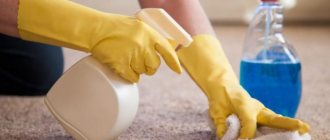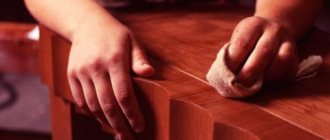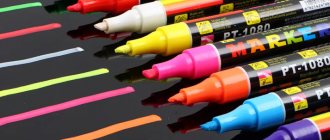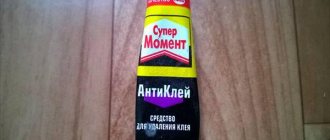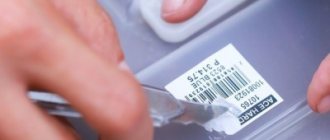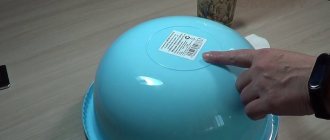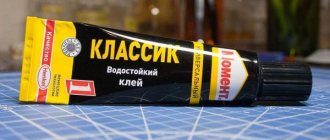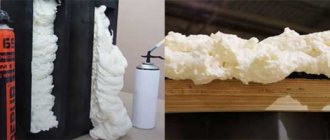It is quite difficult to wash a marker or felt-tip pen with plain water. At first it seems that nothing can remove this caustic dye. But there are products that can clean your favorite sofa or expensive table, giving things a second life. So, baking soda and toothpaste will help remove traces of marker from hard surfaces, and acetone is suitable for cleaning clothes made of thick fabrics.
Removing marker from hard, non-porous surfaces
In this case, it is easiest to remove traces of the marker, since the paint remains in the upper layers, which do not absorb it. They are less sensitive to the effects of alcohol, acetone and other substances; after treatment with these agents, no stains will remain. It is worth keeping in mind that sometimes a marker or felt-tip pen has caustic ink, and in order to wash it completely, you will need to repeat the cleaning several times:
- Rubbing alcohol helps dissolve marker marks. You need to saturate a cloth with it and walk over the contaminated surface. To remove a mark the size of a matchbox, 1-2 tablespoons of alcohol is enough. This way you can clean the table, stove, refrigerator. The product works well with water- or alcohol-based markers. It is better not to rub the stain too much so that it does not increase in size. Through movements one should, as it were, collect the remedy.
- Baking soda and toothpaste also help dissolve marker marks. They are taken in a 1:1 ratio, mixed and applied to the area. Just rub the product in a little and remove it after a few minutes. Then remove the residue with a damp cloth. This method is suitable for linoleum and laminate.
- A melamine sponge is sold in hardware stores, and it is worth purchasing it so that at any time you can simply walk over a surface contaminated with a felt-tip pen, moistening it a little with water. The sponge contains powerful cleaning components, and the rough coating with microscopic “antennae” perfectly removes all contaminants in the upper layers of the material. The reaction will begin in a few minutes and the stain will disappear.
- WD-40 has excellent penetrating properties and can be used to remove stubborn stains. Apply the product for a few minutes and remove with a damp cloth.
Advantages and disadvantages of using different means
Each product has pros and cons of use:
- A mixture of baking soda and toothpaste is always at hand. This is her advantage. The disadvantage is that the effect on cleaning fabrics is not strong enough. In addition, unmixed pieces of soda can damage the surface.
- Alcohol-containing substances can remove marks from any felt-tip pen. They successfully cope with stains on fabrics and plastic. But compared to acetone, alcohol is less effective. When cleaning areas of the body, it dries out the skin.
- Acetone is suitable for removing markers from glass, metal, brick and wood surfaces. It is used if a table or other furniture is dirty. But it is not suitable for removing ink marks from plastic, rubber, lacquered furniture and vinyl wallpaper.
- Objects and substances used for cleaning often have flaws. The comfortable melamine sponge is made of toxic material, and this is its disadvantage. WD-40 is very effective, but contains oils. They leave greasy stains on furniture and wallpaper.
When cleaning any surface in the apartment and areas of the body, do not rub the product too hard. You just need to choose the right cleaning method, and the stain will eventually disappear.
2/5 — (1 vote)
Removing Permanent Ink
Permanent ink is usually very durable, but you can remove marks from it too. The following tools are suitable for this:
- Erasable marker for plastic board. It contains a solvent that removes traces of permanent ink in a few minutes. You need to paint them over with a marker, wait a few seconds and then wipe the surface with a clean sponge or paper towel.
- Sunscreen can be applied in a thick layer to the mark and rubbed in with a cloth or cotton pad. After a few minutes, the stain will begin to fade. Do not leave the cream on the surface too long, as it can damage it. It is enough to wait 10–15 minutes for the pigment to come off.
- Permanent ink can be removed from light fabrics using bleach. It is mixed with water according to the instructions on the package (it is recommended to use 1 tbsp per 3.5 l). The clothes are soaked for 10–15 minutes and then washed. It is important not to overexpose the item in bleach.
- Acne patches work great on hard surfaces by sticking them to permanent ink marks and then quickly pulling them away. Some of the paint will remain on the patch. If necessary, repeat the procedure.
- The well-known acetone also copes well with fresh stains. But after using it, it is important to ventilate the room. Apply a small amount of product to a cotton swab and rub the stain with it until it disappears. Then you can rinse the treated area with water.
- If you don't have any of the above remedies on hand, you can try erasing the permanent ink with a rubber eraser. It is difficult to guarantee results; such a product will help cope with the problem only on a smooth surface.
- To clean satin fabric from permanent ink, you need to mix 1 tbsp. l. milk and vinegar with lemon juice and borax (1 tsp each). Then apply the product to the stain, leave for 10 minutes, and then rub with a damp sponge until the ink marks disappear.
- For regular fabric, use lime or lemon juice. You can dilute it with water to reduce the acid concentration (1:1). Then apply the juice to the stain and rub it into the stain using cotton wool or a cloth. If necessary, you can repeat the procedure, and then rinse your clothes with plain water.
How to clean suede or leather shoes
The material of the shoe determines how to remove marker marks from it. Dermatin or leather is wiped with alcohol or acetone. These substances will not harm the skin or the substitute.
It is more difficult with suede shoes, especially if they are light-colored. To clean suede use:
- Milk. Suitable for light-colored shoes only. A napkin soaked in milk is applied to the soiled suede for 2-3 minutes. When it is soaked, rub it with a special brush for caring for nubuck. The stain is erased in 5-10 minutes.
- Semolina. A small amount of cereal is rolled over the stains until they disappear. The method is labor-intensive. Semolina must be changed after it changes color.
In case of extensive contamination, it is better to take the shoes damaged by marker to the dry cleaner. The workshop uses special reagents and solutions that will clean suede without harming the product.
Cleaning fabrics and leather from marker
The main problem is that the color penetrates quickly and deeply into the tissue structure. It becomes more difficult to get him out. If your favorite jacket or T-shirt is damaged, you can try soaking the item in bleach. But this method is only suitable for light-colored fabrics that are not too sensitive to aggressive chemicals. For example, delicate satin cannot be cleaned this way. But you can try a mixture based on milk, vinegar and borax, which are taken in equal proportions and applied to the stain. After ten minutes, the product is washed off.
Clothing made from thick fabrics can be cleaned with acetone or alcohol. Dermantin or genuine leather - there is no difference. This method can be used for leatherette shoes, but not for suede. In the latter case, it is better to take the items to the dry cleaner.
It is important to remember to wipe the area with a damp cloth, removing traces of the product so that it does not continue to work, corroding the material. You need to be careful with the seams, as they absorb the color. The movements should not be rubbing, but as if collecting dirt.
Cotton items can be cleaned with lime or lemon juice. Alcohol is more suitable for carpet. But in this case, the stain does not need to be rubbed hard so as not to smear it on the fabric. To enhance the effect, you can apply hairspray on top.
Precautionary measures
If used incorrectly, home remedies to remove markers are not safe. When working with them you will need to take the following precautions:
- Hairspray, acetone and alcohol are flammable substances. They should not be used near open flame sources.
- Bleach leaves chemical burns on the skin and should not be used without rubber gloves. It is also forbidden to bring the jar close to your nose so as not to inhale toxic fumes.
- Before washing off the marker from your body, you must make sure that you are not allergic to the product. To do this, a drop of the substance is applied to the bend of the elbow or the back of the wrist. If there is no redness, itching, or rash, you are allowed to use the chosen method to clean all impurities on the body.
Cleaning carpet, upholstered furniture and clothing with the wrong product will damage them.
Before using the method, it is better to test it on a separate piece of fabric, which is supplied as a sample for such experiments when purchasing an item. The main precaution is to try to keep markers out of the hands of preschool children. They are dangerous not only for the interior, but also for the child himself, if he decides to taste the felt-tip pen. If it was not possible to keep track, damaged items are cleaned immediately. Stubborn stains are more difficult to remove.
How to wash marker off your body and face?
If marks from a felt-tip pen remain on the body, then over time they will go away on their own. But if you need to get rid of them immediately, the following remedies are suitable:
- You can spray hairspray onto the mark, rub it into the skin and try to rinse it off with water. Since the product is aggressive, it is important to apply a moisturizer after using it.
- Oil-based marker can be easily removed with vegetable oil such as tea tree or coconut. They need to treat the area several times, especially if the color is caustic, and then remove the greasy shine; regular soap is suitable for this.
- Hand sanitizers also contain alcohol, which is great for dissolving ink on the skin. It needs to be rubbed in until the paint begins to come off. The whole process takes 15–20 seconds. Afterwards, be sure to rinse the area with warm water.
- If you have insect repellent on hand, you can use that too. The repellent is applied to the dirt and rubbed in. The ink will dissolve in 10-15 seconds.
- You can rub baby oil into the skin and try to remove the marker. Shaving cream works the same way.
How to save painted wallpaper
If a permanent marker gets on paper wallpaper, it will not be possible to clean it. Moisture on the paper causes it to become limp, and the marker penetrates the porous material too deeply.
Remove paint from vinyl or non-woven wallpaper with hairspray. To do this, the outlet of the sprayer is brought close to the mark of the felt-tip pen and pressed on the piston. Cover the wet area with a clean, soft cloth for 5-10 minutes, and then blot it several times.
If you don’t succeed in erasing the felt-tip pen the first time, try again 2-3 times. If there is no result, you will have to get rid of the wallpaper, because the marker is too ingrained and cannot be cleaned.
Other surfaces
To wash car headlights or any metal surface, you need to take White Spirit - a special solvent that is used to dilute paints. They simply need to treat the stain; to do this, they will need to apply a small amount of the product to a rag and wipe all surfaces with it.
To clean car glass, you can use bleach, which will penetrate into the deep layers and remove the felt-tip pen within a few minutes. Apply a small amount of product to a sponge and wipe the stained area, then rinse thoroughly with water.
One of the biggest troubles is marker marks on a wall covered with wallpaper. Hydrogen peroxide or oxygen bleach (Persol, Sodasan, Synergetic) will help. Any of these products should be carefully applied to the area and after 10-15 minutes, remove the residue with a damp sponge. You cannot overexpose them, because the composition of the substances is quite aggressive and can destroy the paper or absorb paint from the main wallpaper pattern.
Easy ways to remove marker
If the composition of the felt-tip pen is unknown, you can try universal products:
- Plastic surfaces can be easily cleaned with acetone. But if you are going to process wood with it, you need to make sure that it is varnished on top. Remember that some solvents damage plastic, so it is important to read the package instructions before using them.
- Wooden materials absorb any substance well, and alcohol will allow the color to penetrate even more into their structure. It is best to use dishwashing detergent in this case. It should be applied and left for 10-15 minutes, then rinsed with water.
- Marks from a felt-tip pen on a window can also be wiped off with detergent or toothpaste, but without abrasive particles in the composition, otherwise small scratches will appear.
- Shaving lotion, like other alcohol-based products, can be used to remove stains. An aerosol deodorant works just as effectively.
Remember, if you don’t know whether a surface can be treated with aggressive substances, try more gentle methods first. In the case of clothes, sometimes it is better to immediately take them to the dry cleaner and not experiment. This is especially true for light-colored items made from delicate fabrics.
Useful tips
To be sure to cope with the task, it is important to consider a number of recommendations:
- Strong substances can dissolve not only the marker, but also the surface itself. In this case, the product should be washed off and wiped off the damaged area as soon as possible.
- No matter how effective the product is, it is first of all important to make sure that it is safe for your hands and that there are no allergic reactions.
- You need to start cleansing with the most gentle substances. If they do not cope with the task, you can switch to more aggressive substances.
- Some solvents promote even deeper absorption of paint, so they need to be tested before use.
- It is better not to use dry powders - they can damage the surface by scratching it.
